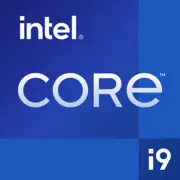Intel Core i9-11950H

Intel Core i9-11950H: A Powerful Processor for Professionals and Gamers. Practical Review of 2025
Introduction: Why Is the Intel Core i9-11950H Still Relevant in 2025?
Despite the release of new generations of processors, the Intel Core i9-11950H remains a sought-after solution for those seeking a balance between performance and mobility. This chip, released in 2021, is still found in premium laptops and workstations. Let's explore who it is suitable for in 2025 and what tasks it can tackle.
Architecture and Process Technology: 10 nm SuperFin and 8 Cores
The Intel Core i9-11950H processor is built on the Tiger Lake-H architecture and the 10-nanometer SuperFin process technology, which has been a breakthrough for Intel. This technology has reduced power consumption and increased clock speeds due to improved transistor structure.
Key Specifications:
- Cores and Threads: 8 cores, 16 threads.
- Frequencies: Base — 2.6 GHz, maximum in Turbo Boost — 5.0 GHz (single core).
- Cache: L3 — 24 MB.
- Integrated Graphics: Intel UHD Graphics for the 11th generation (32 EU, frequency up to 1.45 GHz).
Architectural Features:
- PCIe 4.0 Support: Up to 20 lanes, critical for fast SSDs and external GPUs.
- Thunderbolt 4: Allows the connection of up to four 4K monitors or external drives at speeds up to 40 Gbps.
- AI Acceleration: Intel DL Boost instructions optimize neural network operations in photo and video processing applications.
iGPU: The integrated UHD graphics are suitable for office tasks and light gaming (for example, CS:GO on medium settings delivers 40-50 FPS), but serious gaming requires a discrete graphics card.
Power Consumption and TDP: 35 Watts with Caveats
The nominal TDP of the processor is 35 W, but in reality, it can consume up to 65-80 W in Turbo Boost mode. This creates two key nuances:
1. Heat Generation: An effective cooling system is needed for stable operation. In thin ultrabooks, clock speeds may decrease due to overheating.
2. Performance Balance: In laptops with improved cooling (for example, the MSI GE76 Raider), the processor lives up to its potential but increases the weight and thickness of the device.
Performance: From Office Work to Gaming
Office Tasks and Multimedia:
- Chrome with 50+ tabs + Zoom + Excel: The processor handles this without lag thanks to its 16 threads.
- 4K Editing in DaVinci Resolve: Rendering a 10-minute video takes about 12 minutes (for comparison, Apple M1 Pro does it in about 9 minutes).
Gaming:
- Cyberpunk 2077 (1080p, low settings) + NVIDIA RTX 3060: 55-60 FPS.
- Turbo Boost in Games: Frequencies remain at 4.2-4.5 GHz, but after 30-40 minutes of play, throttling starts in compact cases.
Turbo Mode: Pros and Cons
- Peak Performance: In short-term tasks (like code compilation), it speeds up operations by 25-30%.
- Thermal Risks: In laptops without vapor/heat pipes (for example, Dell XPS 15), Turbo Boost is almost inactive.
Use Cases: Who Needs the i9-11950H?
1. Professionals: Video editors, programmers, CAD engineers.
2. Gamers: For gaming when paired with discrete graphics (RTX 3060 and above).
3. Mobile Users: Those who need power in a compact design (for example, Razer Blade 15).
Example: A laptop based on the i9-11950H priced at $1500-1800 (2025) presents an alternative to more expensive models with Intel Core i7-13700H.
Battery Life: How Long Will the Battery Last?
- Average Runtime: 5-7 hours under moderate load (web browsing, office work).
- Power-saving Technologies:
- Intel Speed Shift: Dynamically adjusts frequencies based on load.
- Adaptix Thermal Framework: Manages fans to minimize noise.
Tip: To extend battery life, disable Turbo Boost in the power settings—this can add 1-2 hours of use.
Comparison with Competitors: AMD, Apple, and Previous Generations
AMD Ryzen 9 5900HX (2021):
- Pros: Better multithreaded performance (+15% in Cinebench R23).
- Cons: Weaker in single-threaded tasks (-10% in Geekbench 6).
Apple M1 Pro (2021):
- Pros: Battery life up to 12 hours, silent operation.
- Cons: Not suitable for Windows applications and AAA games.
Intel Core i7-11800H (2021):
- Lags behind by 12-18% in multithreaded scenarios due to smaller cache.
Pros and Cons of the Processor
Strengths:
- High single-thread performance.
- Support for Thunderbolt 4 and PCIe 4.0.
- Optimal for hybrid tasks (gaming + work).
Weaknesses:
- Demands effective cooling.
- Integrated graphics fall short compared to AMD Radeon 680M.
- In 2025, it may seem excessive for basic tasks (like office work).
Recommendations for Choosing a Laptop
1. Type of Device:
- Gaming Laptop: ASUS ROG Strix Scar 15 (price starting from $1600).
- Workstation: Lenovo ThinkPad P1 (price starting from $1900).
- Ultrabook: HP Spectre x360 (price starting from $1400, but throttling may occur).
2. What to Pay Attention To:
- Cooling System: At least two fans and four heat pipes.
- Battery: Minimum of 80 Wh for 6+ hours of autonomy.
- Display: For professional work—a 4K display with 100% sRGB color coverage.
Final Conclusion: Is It Worth Getting a Laptop with i9-11950H in 2025?
This processor is suitable for those who:
- Seek a balance between price and performance: On the second-hand market, laptops with i9-11950H are priced 20-30% lower than similar models with new chips.
- Work with "heavy" applications: For example, AutoCAD or Premiere Pro.
- Value versatility: The ability to game and work without compromises.
Key Benefits: Power for multitasking, support for modern interfaces, and relative affordability in 2025. However, if battery life and quiet operation are priorities—consider laptops with Apple Silicon or AMD Ryzen 7000.
Basic
CPU Specifications
Memory Specifications
GPU Specifications
Miscellaneous
Benchmarks
Compared to Other CPU
Share in social media
Or Link To Us
<a href="https://cputronic.com/en/cpu/intel-core-i9-11950h" target="_blank">Intel Core i9-11950H</a>